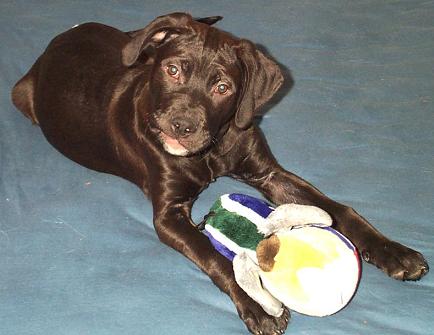Note: This is a guest post by Stephanie Feldstein. Stephanie is the author of “Downward Dog,” a novel inspired by her experience as a pitbull advocate. She recently launched Patient Pup Training, a dog behavior consulting and in-home dog training business.
We’ve had a lot of scares in recent years with pet food recalls, but at least the Food and Drug Administration makes a small effort with some basic standards for pet food such as requiring the food is produced under sanitary conditions, contains no harmful substances and is truthfully labeled.
But what about all the other things your dog puts in his mouth?
Dog toys are meant to be chewed on, and many other pet products (as well as shoes, kids’ toys, and other human stuff) end up in their mouths whether they’re going through puppy stages or ingesting household dust through regular sniffing and licking.
 There are currently no standards that regulate pet products – how they’re made or what goes in them. When the Ecology Center recently tested hundreds of pet products, almost half the products had detectable levels of one or more hazardous chemicals.
There are currently no standards that regulate pet products – how they’re made or what goes in them. When the Ecology Center recently tested hundreds of pet products, almost half the products had detectable levels of one or more hazardous chemicals.
According to the standards set for children’s products, some of these items would have been pulled from the shelves due to high levels of lead.
These test results – along with the chemical content of cars, children’s products and clothing accessories – can be found at HealthyStuff.org, where you can search for your dog’s favorite toys or his bed and recommend products for future testing if they aren’t listed.
Which dog toys are safe?
Unfortunately, you can’t tell just by looking at a ball or collar, or even by sticking with Made in USA labels, whether it has chemicals or not. If you play fetch with a tennis ball bought from a pet store instead of a sports store, it’s possible that your tennis racquet is exposed to less lead than your dog.
It’s upsetting that chemicals were found in nearly half the products. But that means the other half tested clean, so you have choices when you shop.
The pet industry is expected to exceed $45 billion next year and there’s no way everything on the shelves can be tested. The good news as a dog owner is you can use your purchasing power to pressure manufacturers and lawmakers to protect our pets. You can find other easy tools to help you speak up for your furry family members at HealthyStuff.org’s Take Action pages.
It’s true that we don’t know exactly what these results mean for the health of our pets. There hasn’t been much research done in this area. But when there are safe options available, why would we choose to expose our pets and ourselves to toxic chemicals?

Lindsay Stordahl
Sunday 27th of September 2009
Very good points! I hadn't thought of the difference in the sizes of the dogs.
Mark Van Wye
Saturday 26th of September 2009
It is indeed incredible that there is no current body assigned the task of regulating dog toys. I'd like to note, however, that with dogs there is the complication factor of the enormous range of body weight among breeds. Toxins, unfortunately, are in everything we use, eat, wear, drink, etc. Many toxins are natural by-products of one or another aspect of fabrication. (With dog toys, lead is not the only culprit; cadmium and chromium are often found in dog toys and pose similar threats.)
It all comes down to setting acceptable standards, as the FDA has done with many categories of consumables. But how will they arrive at acceptable standards? Just as children's products are subjected to different scrutiny than adult ones, due to the difference in size/weight, what breed will be used as the standard for a future regulatory body?
A great dane can safely chew on a tug with a certain amount of chemicals; but that same tug, if gnawed on by a Pomeranian could be lethal. Will they build standard levels around teacup and toy breeds, to err on the side of safety?
It's a complicated issue, but a critical one. I'm glad that many major retailers are conducting their own in-house testing and vetting, standing in for government regulation in the interim.
Lindsay Stordahl
Thursday 24th of September 2009
Ace doesn't have many toys either, not because he doesn't like them but because I don't bother buying them. I get him stuffed animals from garage sales, and tennis balls from sports stores (they're cheaper there).
Jan
Thursday 24th of September 2009
My dogs have never cared much for pet toys.And from what i read recently I'm glad. They love stuffed animals though.
Apryl DeLancey
Thursday 24th of September 2009
Great information! Gus doesn't get too many toys since he completely devours them in a matter of minutes. I end up taking them away in many pieces.